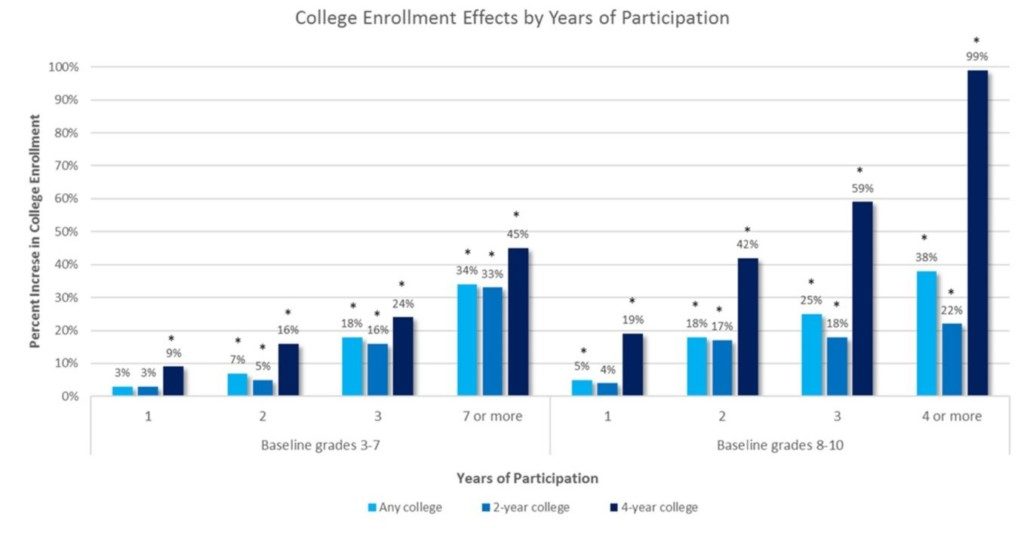
The largest private school choice program in America got more solid evidence of its effectiveness Monday.
The lower-income, mostly minority students using the Florida Tax Credit Scholarship to attend private schools are up to 43 percent more likely to enroll in four-year colleges than like students in public schools, and up to 20 percent more likely to earn bachelor’s degrees, according to a new study released Monday by the Urban Institute.
The outcomes are even stronger for students who use the scholarship four or more years. Those students are up to 99 percent more likely to attend a four-year college than their public school peers, and up to 45 percent more likely to earn bachelor’s degrees.
The new findings build on a 2017 study that was the first of its kind, but also more limited. The previous study found scholarship students were more likely to enroll in college and earn associate degrees, but not significantly more likely to earn four-year degrees. However, the 2017 study only included data from public colleges in Florida, and the researchers cautioned that, as a result, “our results may understate the true impact of FTC participation on college enrollment and degree attainment.”
This time, researchers Matthew M. Chingos, Tomas Monarrez and Daniel Kuehn included private colleges and colleges outside of Florida. They also included college enrollment data through 2018, resulting in a much bigger pool of students to examine.
The researchers reported the outcomes for two groups of students: those who began using scholarships in grades 3-7, and those who began using scholarships in grades 8-10. The scholarship students in both groups posted better results, across the board, than their non-FTC counterparts.
Students who began using the scholarship in grades 3-7 were 12 percent more likely to enroll in any college, and 16 percent more likely to enroll in a four-year college. For students who began using the scholarship in grades 8-10, the corresponding figures were 19 percent and 43 percent.
Those students were more likely than non-FTC students to earn bachelor’s degrees, too. Those who began using the scholarship in grades 3-7 were 11 percent more likely. Those who began using the scholarship in grades 8-10 were 20 percent more likely.
The study also found, as did the 2017 report, that long-term outcomes improved the longer the students used the scholarship. For example, students who began using the scholarship in grades 8-10, and used the scholarship four or more years, were 99 percent more likely to enroll in four-year colleges and 45 percent more likely to earn bachelor’s degrees.


The latest findings are sure to add to the debate about the best way to drive quality in public education.
Critics often argue that private school choice programs are not “accountable” enough. In Florida, for example, private schools participating in state-supported choice programs are not required to be accredited (though many are), or to have state-certified teachers (though many do). Supporters, by contrast, have pushed for what they consider a more effective balance between accountability through regulations, and the accountability that comes when parents have the power, via portable scholarships, to stay or leave.
The Florida Tax Credit Scholarship, created in 2001 and funded through corporate contributions, now serves 99,453 students in 1,799 private schools. It’s administered by nonprofits such as Step Up For Students, which hosts this blog.
Sixty-eight percent of FTC scholarship students are black or Hispanic, their average family income is about $25,755 a year, and a decade’s worth of standardized test scores shows they were typically the most struggling students in their prior public schools. According to the most recent funding comparison across education sectors, the value of a tax credit scholarship is 55 percent of average per-pupil spending in Florida district schools.
The Urban Institute researchers used data from the Florida Department of Education and Step Up to match scholarship students to public school students with a list of similar characteristics, including age, grade, race, language, disability status, free lunch participation, and math and reading scores. “However,” they cautioned, “it still leaves open the possibility that participants and non-participants differ in unmeasured ways, such as parental engagement, family religiosity, or experience in the public school.”
Other studies that gauged long-term outcomes for private school choice programs also found encouraging evidence. Students in the D.C. Opportunity Scholarship Program were significantly more likely to graduate from high school, for example, while voucher students in Milwaukee were more likely to enroll and persist in college.
Step Up For Students research manager Dava Hankerson Fedrick contributed to this post.


